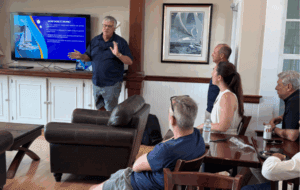How Safe Are Catamarans For Blue Water Sailing?
But What If They Capsize?
“I have heard concerning stories about cats flipping in strong winds”. This question comes up more often as more people are sailing and chartering catamarans. People generally love the comfort, space and performance of a catamaran, but are concerned about the safety of a catamaran versus a monohull on the open ocean. We had a 45 ft monohull that we cruised on for 34,000 NM and we have done about 15,000 NM miles on different cats, all in different conditions and oceans. We have been in very bad weather in both and they are both survivable. We cruise on our catamaran with a sea anchor (a 15 ft diameter parachute) in case of a storm and quite frankly, when we’re hanging on the sea anchor we are as safe as any monohull in similar conditions.
Many experts in the industry like Mark Ellington, managing director of Multihull Solutions and Jon Morris, managing director of long-respected boat builders, McConaghy Boats, unequivocally: “Capsizing is a myth”. Modern cruising catamaran design has critical design criteria that safeguards against this very thing. They are designed with a low centre of gravity and a safe power-to-weight ratios to ensure that it is virtually impossible to lift a hull, regardless of the conditions. That of course excludes performance and racing catamarans where these vessels are pushed beyond reasonable conditions.
Catamarans Can Outrun Bad Weather
With the modern technology for weather forecasting available today, one doesn’t need to be in severe weather. Since a catamaran can regularly do a 220mile day on passage, it can outrun bad weather fairly easily with some notice or at worst, place oneself in the most favorable position to avoid the brunt of a storm. We have been sideways on a 30 ft wave in a 40 ft catamaran just outside of St. Helena off the West African coast and all the boat did was to skid down the wave sideways, not a pleasant feeling to be sure but definitely not dangerous.
Catamaran Sailing Requires More Careful Seamanship
In serious storms, one does need to be more skilled to handle a catamaran however, the designs of modern catamarans have evolved to be extremely seaworthy and they do not just ‘flip’. In fact the rig or the sails should blow out before the vessel capsizes because the righting moment on a cruising catamaran is such that it is almost impossible to do even if you tried. It really takes an act of incredible “plonkerish” behavior to capsize a modern catamaran in winds under 70 knots.
Sea Action And High Winds Cause Capsizing
We do know of a couple of instances where large waves off Richards Bay on the East coast of South Africa and one off the Wildcoast of South Africa capsized catamarans. However, a monohull in similar conditions would also have capsized but it would have self righted because of its lead keel. A catamaran will not self right, however there is some comfort in the fact that modern catamarans have positive buoyancy, so if you capsize or fracture a hull, you will not sink like a mono hull can. You could stay with the vessel for shelter and protection until you are rescued. Survival of the crew in that case is much elevated. The risk of capsizing is something we are prepared to live with (it could happen on any boat) and if you sail your catamaran conservatively, this should not even be an issue. Racing Catamarans often capsize because they are little more than Hobie Cats driven to the edge under extreme conditions, so it really should not be in this discussion.
Catamarans Have Redundancy
Another positive safety issue is of course redundancy. Cruising catamarans have two diesel engines and an engine failure on a catamaran is not a catastrophe like it could be on a monohull. I remember being in this very predicament on my monohull when cruising in the Mediterranean off the coast of France. It was a real bugger navigating past the obstacles (naturally we were close to the coast when disaster struck) and sailing into a crowded anchorage. If I had been on my catamaran, I simply would have motored in on one engine. The second engine can still move the boat, create electricity and charge batteries, so no problem.
Crew Fatigue Is A Safety Issue
The last issue concerning safety is tired, over worked crew. Crew “fatigue” is negligible on a catamaran. You generally get a good sleep even in rough seas. Sail changes and reefing is much easier and safer as you operate on a more stable and flat platform and the risk of serious injuries and falling overboard is diminished considerably. Fresh and alert crew contributes to a much safer vessel.
Stephen says “I was once a dyed in the wool monohull guy until I had the opportunity to spend time on catamarans and it did not take me long to get it. Catamarans are fast, stable, comfortable and as safe as any vessel out there”.





